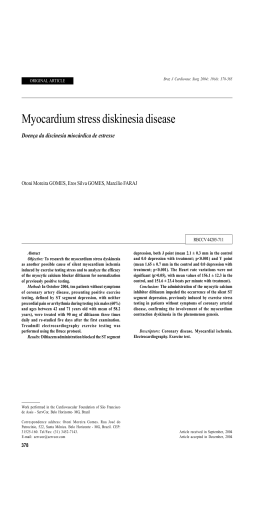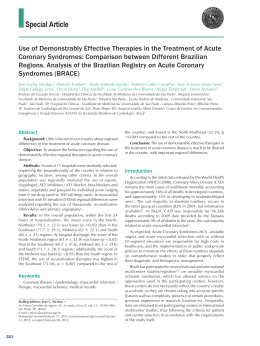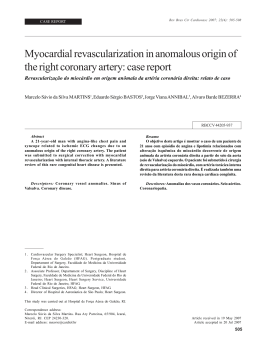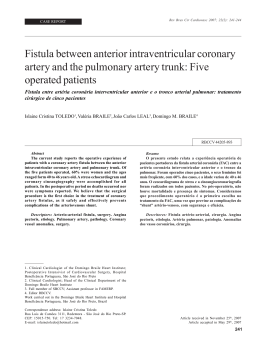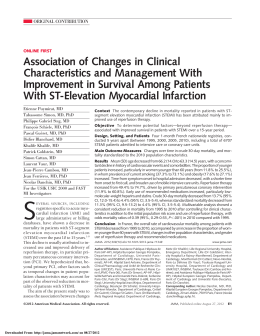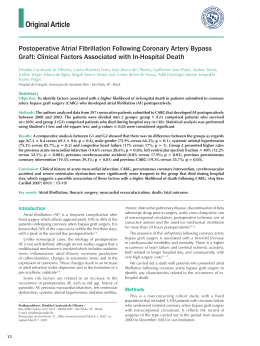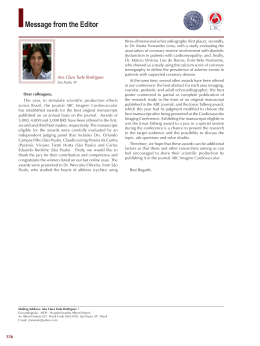REVIEW ARTICLE Rev Bras Cir Cardiovasc 2011;26(3):440-6 Absence of arteriosclerosis in intramyocardial coronary arteries: a mystery to be solved? Ausência de arteriosclerose na porção intramiocárdica das artérias coronárias: um mistério a ser resolvido? Edvaldo Luiz Ramalli Jr1, Leonardo Henrique Braga1, Patricia Martinez Evora2, Agnes Afrodite Sumarelli Albuquerque3, Andrea Carla Celotto4, André Lupp Mota5, Paulo Roberto Barbosa Evora6 DOI: 10.5935/1678-9741.20110020 RBCCV 44205-1301 Abstract Several studies show that portions of intramyocardial coronary arteries are spared of arteriosclerosis, involving morphological, embryological, biochemical and pathophysiological aspects. Endothelial function is significantly affected in the segment of transition, as estimated by the vasoactive response to Ach. These findings suggest that myocardial bridge can provide protection against arteriosclerosis by counteracting the negative effects of endothelial dysfunction. The intramyocardial portion’s protection phenomenon deserves further scientific research on all research fronts. Improved morphological, biomechanical and especially physiological and embryological knowledge may be the key to a future window of opportunity for chronic arterial disease therapy and prevention. In addition, this review discusses possible therapeutic approaches for symptomatic coronary ischemia caused by myocardial bridges. Resumo Diversos estudos demonstram que as porções intramiocárdicas das artérias coronárias são poupadas da arteriosclerose, envolvendo aspectos morfológicos, embriológicos, biomecânicos e aspectos fisiopatológicos. A função endotelial é significativamente afetada no segmento de transição, tal como estimado pela resposta vasoativa para acetilcolina (Ach). Esses achados sugerem que ponte miocárdica pode fornecer proteção contra a arteriosclerose, por contrariar os efeitos negativos da disfunção endotelial. O fenômeno dessa proteção da porção intramiocárdica merece maior investigação científica em todas as frentes de pesquisa. Maiores conhecimentos sobre os aspectos morfológicos, biomecânicos e, principalmente, fisiológicos e embriológicos podem ser a chave para uma futura janela de oportunidades de terapia e prevenção da doença arterial crônica. Nessa revisão, discutemse, também, possíveis abordagens terapêuticas para fenômenos coronarianos isquêmicos causados por pontes miocárdicas. Descriptors: Myocardial bridging. Coronary circulation. Endothelium. Descritores: Ponte miocárdica. Circulação coronária. Endotélio. 1. Graduate student; Monitor, Surgery and Anatomy Department of Faculdade de Medicina de Ribeirão Preto da Universidade de São Paulo, Ribeirão Preto, SP, Brazil. 2. Veterinary Medicine; Graduate School of Veterinary Sciences of Jaboticabal – UNESP, Jaboticabal, SP, Brazil. 3. Biologist; Biologist, Laboratory of Vascular Reactivity and Endothelial Function, Ribeirão Preto, SP, Brazil. 4. PhD; Head of the Laboratory of Biomedical Vascular Reactivity and Endothelial Function, Ribeirão Preto, SP, Brazil. 5. Physician; Resident of Surgery and Anatomy Department of Faculdade de Medicina de Ribeirão Preto da Universidade de São Paulo, Ribeirão Preto, SP, Brazil. 6. Full Professor; Department Chief of Faculdade de Medicina de Ribeirão Preto da Universidade de São Paulo, Ribeirão Preto, SP, Brazil. Work performed at Surgery and Anatomy Department of Faculdade de Medicina de Ribeirão Preto da Universidade de São Paulo, Ribeirão Preto, SP, Brazil. 440 Correspondence Paulo Roberto B. Evora. Rua Rui Barbosa, 367, apto.15 – Ribeirão Preto, SP, Brazil – CEP 14015-120 E-mail: [email protected] Support: Fundação de Apoio ao Ensino, Pesquisa e Assistência do HCFMRPUSP – FAEPA Article received on February 17th, 2011 Article accepted on June 18th, 2011 Ramalli Jr EL, et al. - Absence of arteriosclerosis in intramyocardial coronary arteries: a mystery to be solved? INTRODUCTION Several studies show that portions of intramyocardial coronary arteries are spared of arteriosclerosis, this phenomenon is easily demonstrated in the Anterior Interventricular Artery, better known as anterior descending artery (nomina to be used in the text) and the marginal branches of the circumflex artery (Figure 1) [1,2]. The “myocardial bridge” and the differences between the wall thickness of intramyocardial coronary arteries and other coronary arteries have been described approximately 60 years ago by Geiringer [3]. However, this “natural prevention” that spares most intramyocardial portions from arteriosclerosis, while the epicardial portions are severely involved, has been poorly investigated and discussed [3,4]. Thus, the purpose of this review is to describe, briefly, the possible pathophysiological mechanisms of this phenomenon and its important implications for diagnosis and treatment of coronary disease. In this way, the involved morphological, embryological, biomechanical and physiopharmacological aspects will be discussed. In addition, possible therapeutic approaches to coronary ischemic phenomena caused by myocardial bridges are also discussed. Furthermore, this review followed, in general, the textual formatting of the review published by Botta & Elefteriades [1]. Rev Bras Cir Cardiovasc 2011;26(3):440-6 the 50s, Geiringer published that the intramyocardial coronary artery wall is thinner than the wall from the epicardial portion [3,5]. The vessel´s wall thickness itself is an arteriosclerosis protective factor that is little elucidated [1]. In 1951, Geiringer also reported that the intramyocardial arteries lack vasa vasorum, as they have thin walls and their supply of cell oxygen and nutrients occur by simple diffusion [3,5]. Ever since the nineteenth century, there was evidence that the vasa vasorum played a key role in the arteriosclerosis development [6]. Laterin in the 80s, it was proved that the vasa vasorum is involved in the coronary disease progression and preventing its formation prevents arteriosclerosis (Figure 2) [7]. Fig. 2 – Main anatomofunctional and embryological aspects EMBRYOLOGICAL ASPECTS Fig. 1 - Major anatomopathological aspects (adapted Bourassa and colleagues [35]) MORPHOLOGICAL ASPECTS The morphological features possibly related to the intramyocardial portion´s “natural protection” in relation to arteriosclerotic disease were the first to be described. In The vascular smooth muscle cells of coronary arteries are distinct from those of the proximal aorta through a series of structural and functional criteria, mainly related to myosin heavy chains isoforms in vascular smooth muscle denominated SM1, SM2, and Smemb. This proves that the coronary arteries are not derived from the aorta. These morphofunctional differences may explain the increased propensity for arteriosclerotic transformation. Currently, the source of this variation among subpopulations of smooth muscle is uncertain. Although the proximal aorta´s smooth muscle is known to be derived from the neural crest, the origin of coronary vascular smooth muscle remains uncharacterized [8]. It is more likely that the adventitia and media of coronary arteries are derived from pericardial mesoderm, and if cell migration is incomplete, the intramyocardial part of the coronary arteries could have different structural composition from the remaining parts of the coronary arteries. This may explain the lower susceptibility of intramyocardial coronary to arteriosclerosis [1,9] (Figure 2). The relationship between anatomic 441 Ramalli Jr EL, et al. - Absence of arteriosclerosis in intramyocardial coronary arteries: a mystery to be solved? Rev Bras Cir Cardiovasc 2011;26(3):440-6 variations of the myocardial bridges with a predisposition to the risk of cardiac ischemia is still a detail to be clarified [10,11]. oxide (NO), in protecting myocardial bridges are the main hopes for intervention and possible coronary disease solution. BIOMECHANICAL ASPECTS The two morphological factors mentioned (wall thickness and absence of vasa vasorum) and embryological factors, are unable to explain, by themselves, the protection of the myocardial bridge in relation to arteriosclerosis. Thus, the first assumptions regarding the biomechanical aspects to elucidate this phenomenon emerged. It is known that some mechanical forces such as blood flow are responsible for shear stress and the pressure gradient is responsible for mural stress. These phenomena play a key role in the occurrence and location of arteriosclerosis, interfering with the delicate functional balance between endothelium protective factors and causes of arteriosclerosis. This is easily evidenced on clinical observation of the arteriosclerotic lesions predilection for local curvature, bifurcations, branches and dilatation of the arteries. This motivated the search for factors related to the pressure gradient, the myocardial contraction and protection against arteriosclerotic lesions. The pressure gradient through the coronary arteries wall is given by the difference between the intravascular blood pressure and tissue pressure, according to modified Laplace’s law. The myocardial bundles contraction, around intramyocardial coronary arteries, produce a tissue pressure close to, or even greater than, the intravascular blood pressure, especially in systole. This significantly reduces mural stress, and therefore plays a key role in protecting the intramyocardial portion of the arteries from arteriosclerotic lesions [4]. This reduction is directly proportional to how deep the artery is in the myocardium. Robicsek & Thubrikar [4] have published mural stress reductions ranging from 63% to 80% depending on the artery’s depth in the myocardium during systole and concluded that the intramyocardial coronary always have a significant positive pressure in their surrounding areas, reducing the transmural gradient and, consequently, the mural stress, thereby protecting the intramyocardial portions from arteriosclerosis. PHYSIOPHARMACOLOGICAL ASPECTS The physiological aspects have arisen due to the extension of arteriosclerosis pathogenesis research and the research of biomechanical factors that protect the intramyocardial portion, and currently have the greatest perspective of evidence that could finally elucidate this phenomenon. Paracrine signaling from adipose tissue, and especially the role of vasoactive agents, including nitric 442 Paracrine signaling of epicardial adipose tissue The physiological role of epicardial adipose tissue is not yet fully elucidated. It has been proposed that epicardial tissue acts as a buffer that protects the heart from its large exposure to high levels of circulating fatty acids, or, as a local energy resource for the myocardium during high demand times. However, increasing evidence suggests that epicardial adipose tissue may interact with the myocardium and coronary arteries. This tissue could locally modulate the heart and coronary circulation through paracrine secretion of pro and anti-inflammatory mediators, leading to the hypothesis of a dual role played by epicardial adipose tissue [12]. Little is known regarding the relationship between epicardial adipose tissue and arteriosclerosis. The factors that influence on the balance between protective effects and harmful effects of paracrine secretion are not well elucidated. Inflammatory mediators such asadiponectin and adrenomedullin seem to play a protective effect, while the pro-inflammatory mediator such as interleukins1and 6 (IL-1, IL-6) and tumor necrosis factor alpha (TNF-á ) supposedly exert detrimental effect [12] (Figure 3). Fig. 3 – Major pharmacological aspects Expression of vasoactive agents In 2001, Masuda et al. [13] investigated the relationship between the expression of main vasoactive agents such as endothelin-1 (ET-1), the angiotensin converting enzyme (ACE) and endothelial nitric oxide synthase (eNOS), with its location in relation to myocardial bridge and the degree of involvement by arteriosclerosis. They found that in the intramyocardial portion of the left anterior descending artery there was no histopathological sign indicating the beginning of arteriosclerosis in the intima and that the Ramalli Jr EL, et al. - Absence of arteriosclerosis in intramyocardial coronary arteries: a mystery to be solved? Rev Bras Cir Cardiovasc 2011;26(3):440-6 arteriosclerosis rate is significantly smaller in the myocardial bridge portion in relation to the proximal and distal segments of the bridge. They noted that the expression levels of eNOS, ET-1 and ACE are significantly higher in the portions proximal and distal to myocardial bridge than in the portion underneath the bridge. They established a significant association between both the differential expression of vasoactive agents along the anterior descending coronary artery with less expression in the myocardial bridge as an association between decreased expression of vasoactive agents with lower arteriosclerosis rates. It was demonstrated that the expression of vasoactive agents is related to an altered hemodynamic stress on the vascular wall, suggesting that the decrease of shear stress, beyond interfering with the lipid transfer phase to the vascular wall in arteriogenesis, also works to reduce the expression of vasoactive agents (Figure 3) [13]. recognized as an important influence on endothelial function. The high intravascular pressure has been associated with a state of endothelial dysfunction with impaired endothelium-dependent relaxation. As already mentioned, the expression of vasoactive enzymes, such as eNOS, ET-1 and ACE, is suppressed under a myocardial bridge. It is known that endothelial dysfunction, signaled by endothelium-dependent vasodilation, is an initiating factor in the pathogenesis of atherosclerosis and coronary artery intimal changes. Numerous reports and daily practice of myocardial revascularization surgery showed that the intima of internal arterial segments of the myocardial bridge is spared from arteriosclerosis. This was confirmed by histopathology, imaging assisted by computer analysis and studies using intracoronary ultrassound (ICUS), however, contrary evidence has been reported in some studies with ICUS and anatomical pathology [16]. Thus, the relationship between myocardial bridge and the pathogenesis of arteriosclerosis remains unclear. Endothelial dysfunction has been well proposed as an initial step in the arteriosclerotic process, however the relationship between endothelial dysfunction and arteriosclerosis in segments of transition has been controversial. Even though the relationship between endothelial dysfunction and arteriosclerosis has been described in clinical conditions such as diabetes and hypercholesterolemia, endothelial dysfunction restricted to the site of mechanical compression may reflect the proatherogenic effect, even if modest, in this particular type of endothelial dysfunction. This hypothesis needs to be validated [16-20]. MYOCARDIAL BRIDGE AND CORONARY ENDOTHELIAL DYSFUNCTION Myocardial bridge is a congenital defect, which may present endothelial dysfunction of the coronary´s intramyocardial segment. Some studies have reported that endothelium-dependent vasorelaxation is impaired in this segment of transition. This phenomenon is probably due to a direct action of the myocardial bridge compressing effect on endothelial function. Teragawa et al. [14] reported that patients with myocardial bridge have coronary spasm more frequently than patients without it at an estimated rate of 73% vs. 40%. Herrmann et al. [15] also showed a greater coronary vasoconstriction in response to Ach. Moreover, the mean vasoconstriction in response to maximum Ach was more prominent in inner segments of myocardial bridge than in segments of control patients. These pharmacological data can be related to endothelial dysfunction and spasm in the segment of transition, and maybe a reason for coronary events in patients with myocardial bridge [15,16]. ENDOTHELIAL DYSFUNCTION AND ABSENCE OF ARTERIOSCLEROSIS: AN APPARENT PARADOX A myocardial bridge is characterized by focal systolic compression of a coronary artery by an overlying myocardial band. Chronic compression and relaxation of the bridge can cause endothelial dysfunction by direct stress. Despite the important relationship between myocardial bridge and endothelial dysfunction, the bridge segments are spared from arteriosclerotic plaque formation [16]. Shear stress caused by related blood flow was CLINICAL-SURGICAL IMPLICATIONS The angiographic prevalence of myocardial bridge is reported from 0.5% to 29.4% [25-27] and can result in significant hemodynamic changes in coronary flow, predisposing to cardiac events [28]. However, it is usually considered a benign condition [25], though it has been associated with myocardial ischemia [26], tachycardiainduced ischemia [27], conduction disturbances [28], myocardial infarction [29,30] and sudden death (Table 1) [31]. A recent Brazilian study analyzed the results of 3375 coronary angiographies performed in the period of 2003 to 2007, of which 123 showed the phenomenon of systolic constriction of the left anterior descending artery with the diagnosis of myocardial bridge. The diagnosis frequency of myocardial bridge on cineangiocardiography performed in this period was 3.6% [32]. These data confirm the clinicaltherapeutic importance of myocardial bridges. In excellent “Letter to the Editor”, Barcin et al. [33] summarize the implications of coronary artery revascularization under myocardial bridges. This evaluation was based in a study by Brodsky et al. [34] that suggests 443 Ramalli Jr EL, et al. - Absence of arteriosclerosis in intramyocardial coronary arteries: a mystery to be solved? Rev Bras Cir Cardiovasc 2011;26(3):440-6 that myocardial bridges may be an independent risk factor for developing myocardial ischemia and interstitial fibrosis. The authors came to this conclusion as a result of pathological examination of six patients with intramural left anterior descending artery compared with ten patients without myocardial bridge. This finding is important because data on the prognosis of myocardial bridge are limited. the proximal segment of the myocardial bridges in 12 (86%) of 14 patients with systolic narrowing evidence. These arteriosclerotic regions may also be the source of thrombus and microemboli formation. In addition, the management of patients with myocardial bridge showing a “milking effect” is still controversial. Medical therapy, especially beta-blockers is the first line of treatment in this patient group. In patients that do not respond to medical therapy, surgical revascularization or stent implantation are the options. Even though coronary stent is capable of suppressing ischemic symptoms, there is a high rate of in-stent restenosis with stents implanted in segments with myocardial bridge [40]. This finding was corroborated by other studies, including pharmacological stents [41,42]. It is speculated that the in-stent restenosis, which was diffuse in most patients, may be due to vasoactive substances released from the vessel wall, squeezed between the stent and the myocardium, at each contraction [40]. It seems that the stent implantation, at least with metallic stents, should be avoided in myocardial bridges. Studies comparing surgery with stent implantation are still lacking. In a retrospective study, Wan and Wu [43] have shown excellent short and long term results with the surgery and concluded that surgery is better than stent. In conclusion, the best approach for patients with myocardial bridges is still controversial, even if they have “milking effect” on angiography. Metal stents have higher rates of restenosis and results with pharmacological stents do not exist (Table 2). Table 1. Main clinical aspects. Clinical Aspects • Myocardial ischemia • Ischemia-induced tachycardia • Conduction disorders • Myocardial infarction • Sudden death Accumulating case reports in medical literature, as has been said more than once in this text, it is known that myocardial bridges may cause angina pectoris, myocardial infarction, fatal arrhythmias and even sudden cardiac death. On the other hand, considering the high prevalence of these bridges, especially in autopsy series (up to 16% in angiographic series and 8.5% in autopsy series), it might be speculated that most of the myocardial bridges should be “harmless”. Although they seem to narrow the coronary artery in systole, Bourassa et al. [35] demonstrated that the coronary artery obstruction caused by myocardial bridge (“milking effect”) extends to diastole. Doppler flow profile revealed persistent reduction in initial diastolic diameter followed by an abrupt acceleration of diastolic flow and reduction of coronary flow reserve in the intramural coronary arteries. It is not surprising, therefore, that myocardial bridges may lead to coronary ischemia, especially in conditions with increased heart rate where the diastolic phase relatively shortens. The photon emission tomography is the only test that demonstrated that perfusion defects are reversible after exercise stress test in patients with myocardial bridge [36]. To be considered “clinically significant”, it is expected that the bridges cause compression in coronary angiography, in addition to ischemia symptoms [37]. An important point with the study of Brodsky et al. [34] is that there is no information if there was an angiographic narrowing in patients with myocardial bridge, all of whom had interstitial fibrosis. This may raise the question of whether myocardial bridges could lead to ischemia, even in the absence of coronary narrowing in angiography. The answer is probably “yes” because the bridges are susceptible to be dynamic lesions. The “bridged” segment maybe prone to spasm or narrowing, and can occur in conditions where myocardial contractility increases [38]. Moreover, Ge et al. [39] showed arteriosclerotic plaques in 444 Table 2. Major therapeutic aspects. Clinical Treatment • Beta-blockers, calcium antagonists and antiplatelet • Percutaneous angioplasty (?) • Surgical revascularization • Myectomy (with or without bypass) CONCLUDING REMARKS Endothelial function is significantly affected in the segment of transition, as estimated by the vasoactive response to Ach. However, the bridge segments are spared from arteriosclerosis. These findings suggest that myocardial bridge can provide protection against arteriosclerosis by counteracting the negative effects of endothelial dysfunction. The intramyocardial portion´s protection phenomenon deserves further scientific research on all research fronts. Improved morphological, biomechanical and especially physiological and embryological knowledge may be the key to a future window of opportunity for chronic arterial disease therapy and prevention. Ramalli Jr EL, et al. - Absence of arteriosclerosis in intramyocardial coronary arteries: a mystery to be solved? Rev Bras Cir Cardiovasc 2011;26(3):440-6 The most accepted treatment today is the use medications, especially beta-blockers in symptomatic patients or with a history related to myocardial bridge. In situations of inadequate response to medical treatment, the options of surgical treatment with myocardial revascularization or myotomy exist, and also the use of stents, even with high restenosis rate, in cases of surgical contraindication [44,45]. The reference 45 is a review article with a much broader approach and its reading is mandatory for anyone interested in the study of coronary myocardial bridging. Another unconsidered fact in medical literature is the apparent paradox of the fact that the transition coronary segments, in its path limited by myocardial bridge, do not have arterosclerosis, but have endothelial dysfunction with greater chance of spasm. This fact itself suggests that clinical treatment with the option of using beta-blockers, calcium antagonists and antiplatelet agents, is wiser. isoforms as molecular markers for vascular development and atherosclerosis. Circ Res.1993;73(6):1000-12. 10. Ishikawa Y, Akasaka Y, Suzuki K, Fujiwara M, Ogawa T, Yamazaki K, et al. Anatomic properties of myocardial bridge predisposing to myocardial infarction. Circulation. 2009;120(5):376-83. 11. Erbel R, Ge J, Möhlenkamp S. Myocardial bridging: a congenital variant as an anatomic risk factor for myocardial infarction? Circulation. 2009;120(5):357-9. 12. Iacobellis G, Barbaro G. The double role of epicardial adipose tissue as pro- and anti-inflammatory organ. Horm Metab Res. 2008;40(7):442-5. 13. Masuda T, Ishikawa Y, Akasaka Y, Itoh K, Kiguchi H, Ishii T. The effect of myocardial bridging of the coronary artery on vasoactive agents and atherosclerosis localization. J Pathol. 2001;193(3):408-14. 14. Teragawa H, Fukuda Y, Matsuda K, Hirao H, Higashi Y, Yamagata T, et al. Myocardial bridging increases the risk of coronary spasm. Clin Cardiol. 2003;26(8):377-83. REFERENCES 1. Botta DMJ, Elefteriades JA. Why are the intramyocardial portions of the coronary arteries spared from arteriosclerosis? Clinical implications. Int J Angiol. 2009;18(2):59-61. 2. Scher AM. Absence of atherosclerosis in human intramyocardial coronary arteries: a neglected phenomenon. Atherosclerosis. 2000;149(1):1-3. 3. Geiringer E. The mural coronary. Am Heart J. 1951;41(3):359-68. 4. Robicsek F, Thubrikar MJ. The freedom from atherosclerosis of intramyocardial coronary arteries: reduction of mural stress - a key factor. Eur J Cardiothorac Surg. 1994;8(5):228-35. 5. Geiringer E. Intimal vascularization and atherosclerosis. J Pathol Bacteriol. 1951;63(2):201-11. 15. Herrmann J, Higano ST, Lenon RJ, Rihal CS, Lerman A. Myocardial bridging is associated with alteration in coronary vasoreactivity. Eur Heart J. 2004;25(23):2134-42. 16. Kim JW, Seo HS, Na JO, Suh SY, Choi CU, Kim EJ, et al. Myocardial bridging is related to endothelial dysfunction but not to plaque as assessed by intracoronary ultrasound. Heart. 2008;94(6):765-9. 17. Ishii T, Hosoda Y, Osaka T, Imai T, Shimada H, Takami A, et al. The significance of myocardial bridge upon atherosclerosis in the left anterior descending coronary artery. J Pathol. 1986;148(4):279-91. 18. de Winter RJ, Kok WE, Piek JJ. Coronary atherosclerosis within a myocardial bridge, not a benign condition. Heart. 1998;80(1):91-3. 6. Rokitansky C, Swaine WE. A manual of pathological anatomy. vol. 2. London: Blanchard & Lea;1855. 19. Burnsides C, Edwards JC, Lansing AI, Swarm RL. Arteriosclerosis in the intramural and extramural portions of coronary arteries in the human heart. Circulation. 1956;13(2):235-41. 7. Barger AC, Beeuwkes R 3rd, Lainey LL, Silverman KJ. Hypothesis: vasa vasorum and neovascularization of human coronary arteries. A possible role in the pathophysiology of atherosclerosis. N Engl J Med. 1984;310(3):175-7. 20. Ishii T, Asuwa N, Masuda S, Ishikawa Y, Kiguchi H, Shimada K. therosclerosis suppression in the left anterior descending coronary artery by the presence of a myocardial bridge: an ultrastructural study. Mod Pathol. 1991;4(4):424-31. 8. Mikawa T, Gourdie RG. Pericardial mesoderm generates a population of coronary smooth muscle cells migrating into the heart along with ingrowth of the epicardial organ. Dev Biol. 1996;174(2):221-32. 21. Irvin RG. The angiographic prevalence of myocardial bridging in man. Chest. 1982;81(2):198-202. 9. Aikawa M, Sivam PN, Kuro-o M, Kimura K, Nakahara K, Takewaki S, et al. Human smooth muscle myosin heavy chain 22. Noble J, Bourassa MG, Petitclerc R, Dyrda I. Myocardial bridging and milking effect of the left anterior descending coronary artery: normal variant or obstruction? Am J Cardiol. 1976;37(7):993-9. 445 Ramalli Jr EL, et al. - Absence of arteriosclerosis in intramyocardial coronary arteries: a mystery to be solved? Rev Bras Cir Cardiovasc 2011;26(3):440-6 23. Juilliére Y, Berder V, Suty-Selton C, Buffet P, Danchin N, Cherrier F . Isolated myocardial bridges with angiographic milking of the left anterior descending coronary artery: a longterm follow-up study. Am Heart J. 1995;129(4):663-5. 35. Bourassa MG, Butnaru A, Lespérance J, Tardif JC. Symptomatic myocardial bridges: overview of ischemic mechanisms and current diagnostic and treatment strategies. J Am Coll Cardiol. 2003;41(3):351-9. 24. Li JJ. Is myocardial bridging a bridge connecting to cardiovascular events? Chin Med J (Engl). 2010;123(7):964-8. 36. Huang WS, Chang HD, Yang SP, Tsao TP, Cheng CY, Cherng SC. Abnormal 201TI myocardial single photon emission computed tomography in energetic male patients with myocardial bridge. Nucl Med Commun. 2002;23(11):1123-8. 25. Marshall ME, Headley RN. Intramural coronary artery as a cause of unstable angina pectoris. South Med J. 1978;71(10):1304-6. 26. Feld H, Guadanino V, Hollander G, Greengart A, Lichstein E, Shani J. Exercise-induced ventricular tachycardia in association with a myocardial bridge. Chest. 1991;99(5):1295-6. 27. den Dulk K, Brugada P, Braat S, Heddle B, Wellens HJ . Myocardial bridging as a cause of paroxysmal atrioventricular block. J Am Coll Cardiol. 1983;1(3):965-9. 28. Bashour TT, Espinosa E, Blumenthal J, Wong T, Mason DT. Myocardial infarction caused by coronary artery myocardial bridge. Am Heart J. 1997;133(4):473-7. 29. Vasan RS, Bahl VK, Rajani M. Myocardial infarction associated with a myocardial bridge. Int J Cardiol. 1989;25(2):240-1. 30. Morales AR, Romanelli R, Boucek RJ. The mural left anterior descending coronary artery, strenuous exercise and sudden death. Circulation. 1980;62(2):230-7. 31. Bestetti RB, Costa RS, Zucolotto S, Oliveira JS. Fatal outcome associated with autopsy proven myocardial bridging of the left anterior descending coronary artery. Eur Heart J. 1989;10(6):573-6. 32. Pereira AB, Castro DS, Menegotto ET, Amaral WM, Castro GS. Myocardial bridging: therapeutic and clinical development. Arq Bras Cardiol. 2010;94(2):175-81. 33. Barcin C, Kursaklioglu H, Kose S, Amasyali B. Coronary myocardial bridge constitutes a risk: But how to manage it? Int J Cardiol. 2010;138(2):215-6. 34. Brodsky SV, Roh L, Ashar K, Braun A, Ramaswamy G. Myocardial bridging of coronary arteries: A risk factor for myocardial fibrosis? Int J Cardiol. 2008;124(3):391-2. 446 37. Qian JY, Zhang F, Dong M, Ma JY, Ge L, Liu XB, et al. Prevalence and characteristics of myocardial bridging in coronary angiogram: data from consecutive 5525 patients. Chin Med J (Engl). 2009;122(6):632-5 38. Sakuma M, Kamishirado H, Inoue T, Ichihara M, Takayanagi K, Hayashi T, et al. Acute myocardial infarction associated with myocardial bridge and coronary artery vasospasm. Int J Clin Pract. 2002;56(9):721-2. 39. Ge J, Erbel R, Rupprecht HJ, Koch L, Kearney P, Görge G, et al. Comparison of intravascular ultrasound and angiography in the assessment of myocardial bridging. Circulation. 1994;89(4):1725-32. 40. Kursaklioglu H, Barcin C, Iyisoy A, Kose S, Amasyali B, Isik E. Angiographic restenosis after myocardial bridge stenting. Jpn Heart J. 2004;45(4):581-9. 41. Rondan J, Lozano I, Avanzas P, Lopez-Palop R, Vegas JM, Moris C. Drug eluting stents may not be the answer for myocardial bridges. Int J Cardiol. 2007;117(2):e76-8. 42. Kunamneni PB, Rajdev S, Krishnan P, Moreno PR, Kim MC, Sharma SK, et al. Outcome of intracoronary stenting after failed maximal medical therapy in patients with symptomatic myocardial bridge. Catheter Cardiovasc Interv. 2008;71(2):185-90. 43. Wan L, Wu Q. Myocardial bridge, surgery or stenting? Interact Cardiovasc Thorac Surg. 2005;4(6):517-20. 44. Crespo A, Aramendi JI, Hamzeh G, Voces R. Off-pump supraarterial myotomy for myocardial bridging. Eur J Cardiothorac Surg. 2008;34(3):682-4. 45. Möhlenkamp S, Hort W, Ge J, Erbel R. Update on myocardial bridging. Circulation. 2002;106(20):2616-22.
Download
